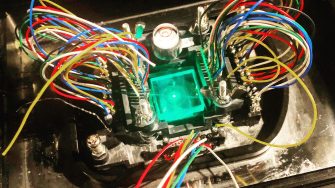
Seeing is believing: Microscopy-capable nanoscale devices for bioelectronics applications
Project ID: 145
Supervisor(s): Adam Micolich
Advanced biosensors featuring nanoscale electronic devices have been the subject of intense research interest for many years. For the most part, such devices have been developed on traditional Si/SiO2 substrates for use as purely electronic sensors without any capacity for simultaneous optical microscopy. In parallel, biological microscopy has made major leaps forward both in resolution and the simplicity and reduced cost of the infrastructure, for example, 3D printed high-resolution microscopes using cellphone cameras are a thriving development frontier presently.
Biological microscopy methods use ultrathin glass, a highly unconventional substrate for nanoscale electronic devices. This 'substrate mismatch' has led to nanoscale electronic biosensors and advanced biological microscopy evolving in isolation despite an interest in similar biological targets and questions. We are currently working on nanoscale electronic devices designed such that biological microscopy can be performed at the device simultaneously with the electrical measurements. The aim is to overcome a major challenge with previous generations of nanoscale electronic biosensors, which is that you cannot *see* what is going on at the device, so it is hard to determine if you are actually measuring reality or just artefacts.
This work involves collaborations with University of Tokyo in Japan, Lund University in Sweden, Swansea University in Wales, Victoria University of Wellington in New Zealand, TU Dresden in Germany and other groups at UNSW (e.g., Lawrence Lee & others in Single Molecule Science, Faculty of Medicine and Damia Mawad in Materials Science).
There are two key directions that we are focussed on with these types of devices.
- Electrical studies of membrane proteins at single molecule level: An important class of proteins are membrane proteins, they are basically functional nanomachines that sit in the fatty lipid bilayer that is used as a wall to separate volumes in biology. These proteins have a variety of roles from triggering the firing of neurons (ion channels) to registering touch (e.g., Piezo) to converting light into voltage (e.g., Rhodopsin) or chemical energy into a voltage (e.g., ATPase). There are still important fundamental physics problems in these proteins, e.g., how exactly do they work, as well as applied problems since they are common drug targets and these types of device structure are being developed for ultra-sensitive virus detection systems.
Our goal is to build structures where the device sits at the bottom of a small micron-sized well that's sealed with lipid bilayer that we can place a small number (0, 1, 2 or so) of membrane proteins in. The substrate is transparent so we can see inside the well during electrical measurements. The aim is to enable simultaneous optical and electrical study of the embedded proteins to better understand function and behaviour.
- Electrical detection of mobile protein molecular motors in biocomputation devices: Linear protein molecular motors play important roles in biology: actin & myosin work together to drive muscle contraction and kinesin & microtubules work together to traffic cargo around cells. For the last two decades, scientists have been playing with these protein systems in a chip-based environment such that the 'walking feet', e.g., myosin and kinesin, are bound to a surface with the feet sticking up and then push 'filaments', e.g., the rodlike proteins actin & microtubules, around like nanoscale trains (see here). Initially this was done simply to see if it can be done (i.e., curiosity) but it quickly evolved into strategies for nanoscale cargo distribution networks and interesting new approaches to solving computationally-intensive problems.
Detection in these systems is entirely done by a microscope and there is a strong incentive to have local nanoscale detectors that operate electrically to, for example, detect traffic in different areas of a cargo network, or read-out solutions in a computation structure. This also requires devices that are compatible with biological microscopy and is part of a collaboration with the EU Horizon-2020 project Bio4Comp.
More details of what we do as a research group can be found at: http://newt.phys.unsw.edu.au/nanoelectronics/
